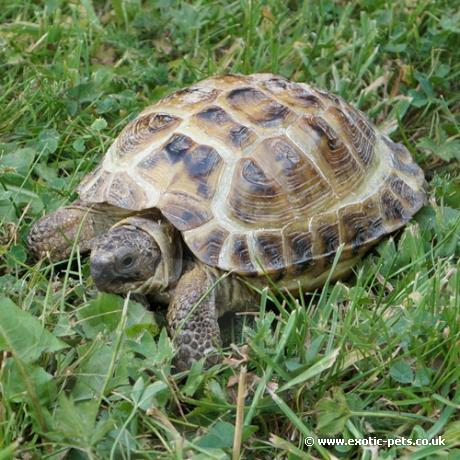

The Horsfield or Russian tortoise is arguably the most popular pet species of tortoise out there due to their smaller size and hardy nature. They are ideal for beginners into the reptile hobby who are interested in keeping Chelonian species.
The Horsfield Tortoise is a small species of tortoise with males tending to grow between 5-8 inches and females being the larger of the two at around 6-10 inches. Males have longer tails than females which they generally tuck into the side of their shell. Males also have a concave shape underneath their shell which aids them during mating. Shell colour is a variable colour of browns and black with yellow between the scutes. The body itself is generally straw-yellow and brown.
Horsfield tortoise are native to Central Asia including the Russian Steppes, Pakistan, Afghanistan, India, Iran and some parts of China. They hibernate during the winter months in their huge burrows which they live, and will estivate (be less active) during the summer months when temperatures exceed levels where it’s not safe for them to venture out! Although very closely related to the Mediterranean species, Horsfield tortoises are actually a very different tortoise. They inhabit dry hillside slopes in some montane regions and are even found in areas what we generally consider to be inhospitable places, near deserts!
Horsfield tortoises do not do well housed in normal reptile type vivariums. It can lead to all sorts of health problems with having constantly high temperatures and uncontrollable humidity. Housing your Horsfield tortoise into a tortoise table such as the new range is by far the best solution as it is extremely well ventilated (allowing better airflow) and it will allow the tortoise to thermoregulate much more freely. They also have the advantage of being extendable!
We recommend using a mercury vapour bulb to heat your tortoise table. These bulbs provide optimal levels of UVB, UVA, visual light and heat all in one bulb, everything a healthy tortoise needs! It is important however that you check the basking temperature you will be providing with this equipment. You’re aiming to reach a basking spot temperature of around 28-30°C and around 20°C on the cool end of the enclosure.
For substrate we would recommend as it’s specifically designed to replicate arid habitats where Mediterranean and Horsfield tortoises are from. Its texture and moisture retention replicates their environment perfectly. With the addition of pure limestone in it means that if the reptiles were to ingest the substrate they are simply only taking in calcium. Horsefield Tortoises are natural burrowers in the wild so unlike their Mediterranean counterparts it pays to provide them with a little more substrate depth within your table to allow them to dig.
It is very important to choose the correct sized feeding and water dishes for your animal and shallow is best for young and adult tortoises alike. They allow the tortoises to reach their food or go for a soak with more ease.
Décor is generally a personal choice, but don’t forget that tortoises need items such as shallow bark or rocks to climb over to keep them active, healthy and mentally stimulated.
We have put together a comprehensive starter kit which we recommend for anybody who wishes to keep a Horsefield tortoise which includes all of the above mentioned products.
Ensuring that you’re tortoise has a well-balanced diet is crucial. These tortoises are herbivorous (plant eating) and they must have a high fibre, calcium-rich, low fat diet to keep healthy! With a bit of forward planning a good diet can be provided mainly consisting of weeds and flowers, we would recommend Dandelion, Bitter Cress, Sow Thistle, Vetch, Rose Leaves, Clover, Dead Nettle, Hibiscus, Lavaterra and Pansies. Many of these food items can be collected from the wild but you must ensure they are collected from chemical free areas. You can also purchase packets of seeds suitable for growing your very own tortoise food, which is great especially for the winter months when it is difficult to source some of the plants they require. These plants can often be grown in window boxes within our homes! DO NOT feed iceberg lettuce or any other head lettuces as they contain very little vitamin and minerals. We have created a list of Reptile Safe Edible Plants to help you to provide a widely varied diet.
It is very important that you supplement the diet of your tortoise with calcium and vitamins to ensure they are getting the perfect balance. You can simply sprinkle the supplements over the top of the food you provide your tortoise- think of it as lightly seasoning the food! This is very beneficial to all reptiles and prevents any horrific problems occurring such as metabolic bone disease.
In addition to this care sheet there are some fantastic books available on tortoises. For a good general read on Tortoises there is a new book on the market written by Pet Expert. These are actually British written books and are easier to follow when compared to some of the American written books especially if you’re a newcomer to the hobby because of the terminology that is used.
Many species of tortoise that are available today are subject to CITES (Convention on International Trade in Endangered Species) article 10 paperwork. This in a nutshell provides a certificate/microchip to prove that these tortoises are captive farmed/captive bred and have not been illegally taken from the wild. This paperwork/microchip is essential if you intend to sell or even breed your tortoise. Tortoise species covered under this act are known as Annex A. Horsfield tortoises however are what’s known as Annex B and require no CITES paperwork. However we would still recommend that you buy your tortoise from a reliable reptile shop to ensure that you will get a healthy captive farmed/captive bred tortoise rather than buying an illegally imported wild caught specimen.